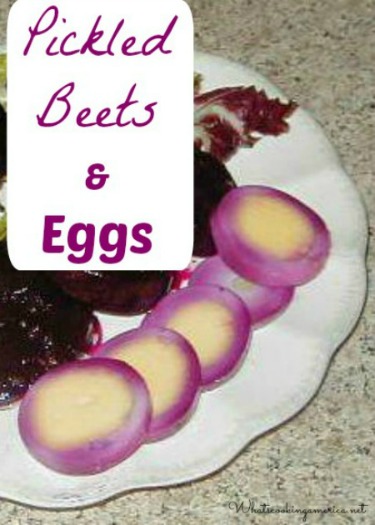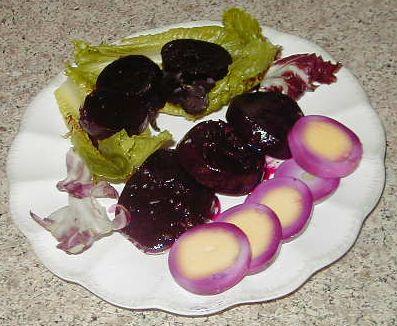Pickled Beets and Eggs recipe is an old Portuguese recipe that my grandparents and mother used to make. They would pick all the fresh beets that were available in their garden. Depending on how many beets were ready to pick, would determine how much they were going to use in the pickling process. Karen says, “There really is no actual recipe, as you use how many beets you have harvested.”
Many beets are sold in bunches with the tops still attached, while others are sold with the tops removed. Look for beets that are firm, round, with a slender tap root (the large main root), a rich, color, and smooth over most of the surface. If beets are bunched, you can judge their freshness fairly accurately by the condition of the tops. Badly wilted or decayed tops indicate a lack of freshness, but the roots may be satisfactory if they are firm. Avoid elongated beets with round, scaly areas around the top surface – these will be tough, fibrous, and strong-flavored. Also avoid wilted, flabby beets — they have been exposed to the air too long.
Pickled Beets and Eggs recipe, comments, and photo were shared with me by Karen Calanchini, Food Stylist and Photographer, of Redding, CA.
Check out my another recipe for old-fashion Pickled Beets and more delicious Beet Recipes.
- 4 to 6 fresh beets
- 5 eggs
- Vegetable oil or canola oil
- Apple cider vinegar or rice vinegar
- Salt and pepper
-
To cook fresh beets:
-
For tender, freshly picked beets - wash, rinse and drain until all traces of garden soil are removed. Use a small vegetable brush if needed.
-
Cut off leaves and stems, leaving about 1 inch of the root end. Please don't throw away those fresh beet greens when cooking fresh beets. Cook the beet greens and enjoy a delicious and nutritious dish just like your grandparents grew up with. Learn How To Cook Fresh Beet Greens.
-
Place beets in large heavy pan and cover with water. Bring just to a boil; reduce heat to medium, cover and cook until fork tender, approximately 25 to 30 minutes. Remove from heat and drain, reserving a little of the beet water.
-
Once cooked, you can peel them; the skin of a cooked beet will slip right off. (However, it's wise to use a paper towel or wear gloves to keep the beet juice from staining your hands.) Then cut the beet in slices.
-
To cook hard-cooked eggs: -
To correctly cook the eggs, place them in a single layer in a pan with enough cold water to cover them completely.
-
Bring the water to a boil, remove from heat, cover tightly with a lid, and allow to remain in the water approximately 15 to 20 minutes.
-
Then place under running, cold water to cool quickly; peel.
-
To Make Pickled Beets and Eggs:
-
Place cooked beets and hard-cooked eggs into a large container with a lid. Add a little of the reserved beet water. Add canola oil or any vegetable oil (do not use olive oil as it will solidify when refrigerated). Add either apple cider vinegar or rice vinegar to taste (any favorite vinegar would work). Add salt and pepper. Shake container to coat the beets and eggs.
-
Place in refrigerator. Stir each day to insure the eggs are evenly dyed with beet juice.
-
After about one (1) week, they are ready to eat. The eggs will have soaked up the red beet juice from the beets.
-
When you slice them, you will see a layer of red, white, and yellow. So pretty!

Pickled Eggs Safety:
Pickled eggs must be stored in the refrigerator for safety.
Be sure that the eggs are covered with the pickling solution during storage.
Pickled eggs should never be at room temperature except for serving time, when they should be limited to no more than two (2) hours in the temperature danger zone of 40 to 140 degrees F.
Categories:
Beet Appetizers Beets Easter Egg Appetizers Egg Recipes Pickles Portuguese Recipes Preserved Foods Index Spring Recipes Summer

